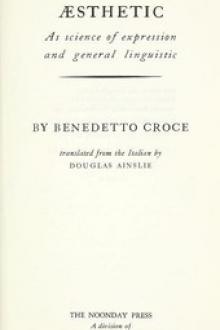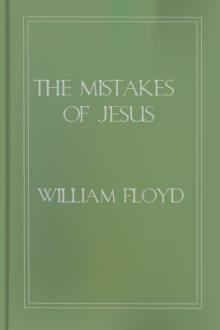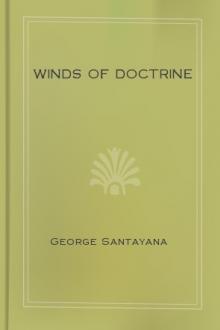The Sense of Beauty, George Santayana [e ink epub reader .txt] 📗

- Author: George Santayana
- Performer: -
Book online «The Sense of Beauty, George Santayana [e ink epub reader .txt] 📗». Author George Santayana
Form the unity of a manifold.
§ 23. Symmetry is evidently a kind of unity in variety, where a whole is determined by the rhythmic repetition of similars. We have seen that it has a value where it is an aid to unification. Unity would thus appear to be the virtue of forms; but a moment's reflection will show us that unity cannot be absolute and be a form; a form is an aggregation, it must have elements, and the manner in which the elements are combined constitutes the character of the form. A perfectly simple perception, in which there was no consciousness of the distinction and relation of parts, would not be a perception of form; it would be a sensation. Physiologically these sensations may be aggregates and their values, as in the case of musical tones, may differ according to the manner in which certain elements, beats, vibrations, nervous processes, or what not, are combined; but for consciousness the result is simple, and the value is the pleasantness of a datum and not of a process. Form, therefore, does not appeal to the unattentive; they get from objects only a vague sensation which may in them awaken extrinsic associations; they do not stop to survey the parts or to appreciate their relation, and consequently are insensible to the various charms of various unifications; they can find in objects only the value of material or of function, not that of form.
Beauty of form, however, is what specifically appeals to an aesthetic nature; it is equally removed from the crudity of formless stimulation and from the emotional looseness of reverie and discursive thought. The indulgence in sentiment and suggestion, of which our time is fond, to the sacrifice of formal beauty, marks an absence of cultivation as real, if not as confessed, as that of the barbarian who revels in gorgeous confusion.
The synthesis, then, which constitutes form is an activity of the mind; the unity arises consciously, and is an insight into the relation of sensible elements separately perceived. It differs from sensation in the consciousness of the synthesis, and from expression in the homogeneity of the elements, and in their common presence to sense.
The variety of forms depends upon the character of the elements and on the variety of possible methods of unification. The elements may be all alike, and their only diversity be numerical. Their unity will then be merely the sense of their uniformity.[6] Or they may differ in kind, but so as to compel the mind to no particular order in their unification. Or they may finally be so constituted that they suggest inevitably the scheme of their unity; in this case there is organization in the object, and the synthesis of its parts is one and pre-determinate. We shall discuss these various forms in succession, pointing out the effects proper to each.
Multiplicity in uniformity.
§ 24. The radical and typical case of the first kind of unity in variety is found in the perception of extension itself. This perception, if we look to its origin, may turn out to be primitive; no doubt the feeling of "crude extensity" is an original sensation; every inference, association, and distinction is a thing that looms up suddenly before the mind, and the nature and actuality of which is a datum of what — to indicate its irresistible immediacy and indescribability — we may well call sense. Forms are seen, and if we think of the origin of the perception, we may well call this vision a sensation. The distinction between a sensation of form, however, and one which is formless, regards the content and character, not the genesis of the perception. A distinction and association, or an inference, is a direct experience, a sensible fact; but it is the experience of a process, of a motion between two terms, and a consciousness of their coexistence and distinction; it is a feeling of relation. Now the sense of space is a feeling of this kind; the essence of it is the realization of a variety of directions and of possible motions, by which the relation of point to point is vaguely but inevitably given. The perception of extension is therefore a perception of form, although of the most rudimentary kind. It is merely Auseinandersein, and we might call it the materia prima of form, were it not capable of existing without further determination. For we can have the sense of space without the sense of boundaries; indeed, this intuition is what tempts us to declare space infinite. Space would have to consist of a finite number of juxtaposed blocks, if our experience of extension carried with it essentially the realization of limits.
The aesthetic effect of extensiveness is also entirely different from that of particular shapes. Some things appeal to us by their surfaces, others by the lines that limit those surfaces. And this effect of surface is not necessarily an effect of material or colour; the evenness, monotony, and vastness of a great curtain of colour produce an effect which is that of the extreme of uniformity in the extreme of multiplicity; the eye wanders over a fluid infinity of unrecognizable positions, and the sense of their numberlessness and continuity is precisely the source of the emotion of extent. The emotion is primary and has undoubtedly a physiological ground, while the idea of size is secondary and involves associations and inferences. A small photograph of St. Peter's gives the idea of size; as does a distant view of the same object. But this is of course dependent on our realization of the distance, or of the scale of the representation. The value of size becomes immediate only when we are at close quarters with the object; then the surfaces really subtend a large angle in the field of vision, and the sense of vastness establishes its standard, which can afterwards be applied to other objects by analogy and contrast. There is also, to be sure, a moral and practical import in the known size of objects, which, by association, determines their dignity; but the pure sense of extension, based upon the attack of the object upon the apperceptive resources of the eye, is the truly aesthetic value which it concerns us to point out here, as the most rudimentary example of form.
Although the effect of extension is not that of material, the two are best seen in conjunction. Material must appear in some form; but when its beauty is to be made prominent, it is well that this form should attract attention as little as possible to itself. Now, of all forms, absolute uniformity in extension is the simplest and most allied to the material; it gives the latter only just enough form to make it real and perceptible. Very rich and beautiful materials therefore do well to assume this form. You will spoil the beauty you have by superimposing another; as if you make a statue of gold, or flute a jasper column, or bedeck a velvet cloak. The beauty of stuffs appears when they are plain. Even stone gives its specific quality best in great unbroken spaces of wall; the simplicity of the form emphasizes the substance. And again, the effect of extensity is never long satisfactory unless it is superinduced upon some material beauty; the dignity of great hangings would suffer if they were not of damask, but of cotton, and the vast smoothness of the sky would grow oppressive if it were not of so tender a blue.
Example of the stars.
§ 25. Another beauty of the sky — the stars — offers so striking and fascinating an illustration of the effect of multiplicity in uniformity, that I am tempted to analyze it at some length. To most people, I fancy, the stars are beautiful; but if you asked why, they would be at a loss to reply, until they remembered what they had heard about astronomy, and the great size and distance and possible habitation of those orbs. The vague and illusive ideas thus aroused fall in so well with the dumb emotion we were already feeling, that we attribute this emotion to those ideas, and persuade ourselves that the power of the starry heavens lies in the suggestion of astronomical facts.
The idea of the insignificance of our earth and of the incomprehensible multiplicity of worlds is indeed immensely impressive; it may even be intensely disagreeable. There is something baffling about infinity; in its presence the sense of finite humility can never wholly banish the rebellious suspicion that we are being deluded. Our mathematical imagination is put on the rack by an attempted conception that has all the anguish of a nightmare and probably, could we but awake, all its laughable absurdity. But the obsession of this dream is an intellectual puzzle, not an aesthetic delight. It is not essential to our admiration. Before the days of Kepler the heavens declared the glory of God; and we needed no calculation of stellar distances, no fancies about a plurality of worlds, no image of infinite spaces, to make the stars sublime.
Had we been taught to believe that the stars governed our fortunes, and were we reminded of fate whenever we looked at them, we should similarly tend to imagine that this belief was the source of their sublimity; and, if the superstition were dispelled, we should think the interest gone from the apparition. But experience would soon undeceive us, and prove to us that the sensuous character of the object was sublime in itself. Indeed, on account of that intrinsic sublimity the sky can be fitly chosen as a symbol for a sublime conception; the common quality in both makes each suggest the other. For that reason, too, the parable of the natal stars governing our lives is such a natural one to express our subjection to circumstances, and can be transformed by the stupidity of disciples into a literal tenet. In the same way, the kinship of the emotion produced by the stars with the emotion proper to certain religious moments makes the stars seem a religious object. They become, like impressive music, a stimulus to worship. But fortunately there are experiences which remain untouched by theory, and which maintain the mutual intelligence of men through the estrangements wrought by intellectual and religious systems. When the superstructures crumble, the common foundation of human sentience and imagination is exposed beneath.
The intellectual suggestion of the infinity of nature can, moreover, be awakened by other experiences which are by no means sublime. A heap of sand will involve infinity as surely as a universe of suns and planets. Any object is infinitely divisible and, when we press the thought, can contain as many worlds with as many winged monsters and ideal republics as can the satellites of Sirius. But the infinitesimal does not move us aesthetically; it can only awaken an amused curiosity. The difference cannot lie in the import of the idea, which is objectively the same in both cases. It lies in the different immediate effect of the crude images which give us the type and meaning of each; the crude image that underlies the idea of the infinitesimal is the dot, the poorest and most uninteresting of impressions; while the crude image that underlies the idea of infinity is space, multiplicity in uniformity, and this, as we have seen, has a powerful effect on account of the breadth, volume, and omnipresence





Comments (0)